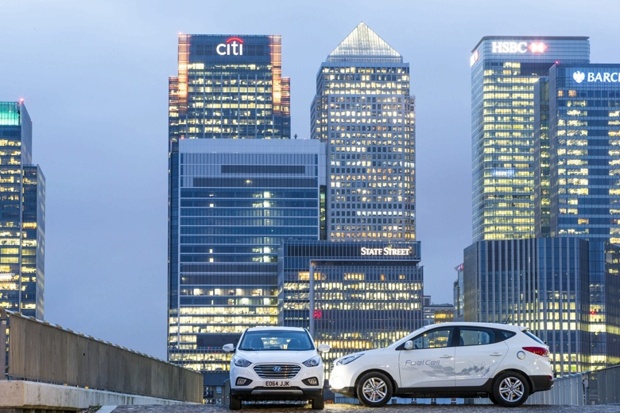They have been tested on its roads and are aimed squarely at its congested, polluted market, but the irony is that London is where hydrogen fuel-cell vehicles work least effectively. That, however, according to their manufacturers, is entirely the point. The clean-up has to begin somehow, somewhere.
As Hyundai launches the ix35 FCEV against the already announced Toyota Mirai, pitching two cars at about £50,000 each at the retail market, attention is focused as squarely on their likely destination.
The cars rely on hydrogen piped at high pressure into their on-car tanks, chemically reacting in fuel cells with oxygen in the air to create an electric current that can keep a motor running for up to 350 miles.
But in central London, where air quality is at its worst, the impurities of nitrogen, carbon and sulphur oxides degrade the expensive fuel cells more rapidly and, in time, affect vehicle performance.
The capital is doing its best to meet the challenge. The chicken-and-egg question of alternatively powered cars — that no one will make them or drive them until someone builds the refuelling network — is being addressed. In addition to two hydrogen refuelling stations at Heathrow and Hendon, ITM Power, the listed renewable technology company, is installing three more in London within the year.
And not only inside the M25. An existing hydrogen station, along the M4 at Honda’s Swindon plant, is to be joined by one north on the M1 at Rotherham. The hope is to strategically locate 60 around the UK until there is a network serving 80 per cent of the country.
There are two “types” of hydrogen. Cheaper, less pure “brown” hydrogen, a byproduct of industrial chemical processes that can be shipped into re-fuelling stations. Or “green” hydrogen produced by electrolysis on site. There are arguments for both. Moreover, hydrogen, unlike petrol or diesel, can be compressed, so refuelling can be carried out at different pressures, 700 bar for a “full tank” giving 350 miles of range, or at 350 bar for the equivalent of half a tank. Facilities for 700 bar delivery are a lot more expensive than for 350 bar.
“We also have a chance to revolutionise the way we refuel,” Robin Hayles, the Hyundai executive in charge of pushing the ix35 FCEV in the UK, said. “We don’t have to follow the conventional fuel station model. What about an 0898 call-out number for a man in a van, a mobile refuelling station that fills your car up when it is standing idle, saving you a trip to the pump?”
Unlike the Toyota Mirai, which is designed and engineered around a fuel- cell stack, Hyundai has put its hydrogen powertrain into its existing ix35 crossover model. Nine are on the road in the UK in corporate hands, feeding data back to the South Korean company, like the two used by Transport for London as bus support vehicles.
The next generation of Hyundai fuel-cell vehicles will have a production run of 15,000, and the proportion bound for the UK, seen as an early-adopting priority market, will depend on the state of the refuelling network.
Tony Whitehorn, the chief executive of Hyundai UK, believes that while people should not get too carried away by hydrogen, it is in the long term “the ultimate solution” — the fuel technology that will supercede all others.
“We have no doubt hydrogen will be the dominant solution. The only thing we don’t know is when,” he said.
Hydrogen is not a nil-cost fuel. The providers, ITM or Air Products, are likely to charge about £60 for a full tank of hydrogen — not dissimilar to the price of petrol — because they need to claw back their investment. In the long term, economies of scale and technological advances should mean that the price of hydrogen falls, just as the price of crude oil is likely to start rising.

